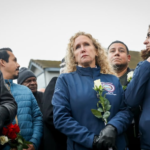Tuesday, April 23`, 2025
Year : 2, Issue: 34
by J. Michael Collins and Tyler Q. Welch
For nearly 100 years, the United States has maintained one of the world’s more successful models of social insurance, protecting Americans from the death of a spouse or parent, disability and old age – essentially the risk of outliving one’s savings.
These are things most of us fear regardless of our means, and – despite the rhetoric – these are not welfare programs. Americans pay into them, and without Social Security, we all will bear more risks that will directly impact our wallets, and potentially the high quality of life we have become accustomed to since its creation.
This is why touching Social Security has been viewed as a “third rail” for decades, and it remains a primary point of contention at the charged town halls across the nation recently.
Social Security keeps thousands out of poverty
You may not think of it when you look at a paystub, but the Old-Age, Survivors, and Disability Insurance (OASDI) line is doing some serious heavy lifting when it comes to many Americans’ financial security. It is a premium that offers coverage from the risks that come from not being able to work.
When we outlive our ability to work, lose a spouse, become disabled or have a dependent with a disability, Social Security programs provide benefits.
Across America, the old age and survivors’ insurance programs reduce the Supplemental Poverty Measure among those ages 65 and older by 33 percentage points, meaning without Social Security, more than 19.5 million adults would have to survive on incomes below the poverty line (less than $16,000 for a single person in 2025).
Among all Americans, Social Security lifts 27.6 million people above the poverty line.
Given the decline of defined benefit pensions, most workers today will have to rely on personal savings. With no guarantee of benefits for life, workers face greater risks of outliving their savings or a major downturn in the market. Social Security mitigates these risks.
What would the average American need to do to make up for large changes to OASDI?
We offer some estimates below, but the answer is straightforward: Save a whole lot more and spend a whole lot more for private insurance coverage.
We also must prepare for the state to bear more of the costs of having more people in deeper poverty in our communities.
Here’s how Americans would fare without Social Security
This is how the impact breaks down in specific areas:
● Retirement. Without any legislative action by Congress, Social Security will have insufficient funds to provide for retirees by 2033. Based on actuarial projections, benefits will have to be cut by 21% immediately. The program will not be “broke” or have “nothing for future retirees.” But benefit amounts will be reduced for current and future retirees. The average worker in the U.S. receives about $1,900 per month. This implies a need for current and future retirees to come up with $4,800 per year to maintain the earning power of today’s Social Security benefits. Seniors will have to cut expenses, use up more savings and rely more on financial support from family members.
● Disability. For the 161 million workers in the U.S., the chance of developing a disability is not small; in fact, a quarter of today’s 20-year-olds will experience a disability before retirement. For an average 40-year-old male, replacing Social Security disability insurance with private coverage would cost roughly $1,200 per year. An estimated 40% of workers have limited disability insurance through an employer, but this coverage offers less protection than Social Security. Moreover, private disability insurers screen applicants, charging some workers more or even denying coverage altogether. Coverage is likely to cost much more than $1,200 per year for some workers – if it is available at all. Social Security provides with the same benefit levels and rules for all workers.
● Survivors’ benefits. As of December 2023, there were more than 5.7 million Americans (more than enough to be the 23rd largest state) receiving Social Security benefits due to a deceased spouse, child or parent. For an average 40-year-old male to purchase similar life insurance coverage privately, premiums would be over $500 per year. Of course, this private coverage is subject to medical exams, and policy renewals come with premium increases. While some private industry workers have limited access to life insurance benefits at work, Social Security survivors’ benefits are especially important for lower-income workers with children who depend on their earnings.
Supplemental Security Income. More than 7.4 million Americans receive more than $63.5 billion in annual payments from SSI. These payments average just over $700 per month for the poorest Americans, including people with disabilities, elderly individuals who had low-paying jobs, and children. If proposals to shift SSI from Social Security to the state occur, the average Wisconsinite would need to contribute $260 per person per year to make up the gap.
● Supplemental Security Income. More than 7.4 million Americans receive more than $63.5 billion in annual payments from SSI. These payments average just over $700 per month for the poorest Americans, including people with disabilities, elderly individuals who had low-paying jobs, and children. If proposals to shift SSI from Social Security to the state occur, the average Wisconsinite would need to contribute $260 per person per year to make up the gap.
In the end, if Social Security retirement benefits are reduced due to legislative inaction, Social Security survivors’ and disability benefits are removed, and SSI’s support for the poorest seniors and people with lifelong disabilities is terminated or handed off to the state, it will cost the average American more than $6,800 per year in added insurance premiums, increased need for savings and state tax increases.
Impact of Social Security Changes Across States Annual Costs
We estimate that this number is more than $7,000 per year in 12 states (highest in Connecticut at $7,279 per year) and is more than $6,400 in every state (lowest in Montana at $6,474 per year).
This likely far exceeds any reasonable reductions in our payroll taxes, and ignores the costs that family members and communities may take on to support the most economically vulnerable.
The insurance protection that Social Security programs provide has tangible economic benefits. Without these programs, we will all need to reassess our financial plans.
Author is a professor in the School of Human Ecology and the La Follette School of Public Affairs at the University of Wisconsin-Madison. He is also an associate director at the Institute for Research on Poverty and a member of the National Academy of Social Insurance.







